
St. Paul’s offers view of 18th century city life
MOUNT VERNON, N.Y.— Throughout history, St. Paul’s Church has served as a hospital, courthouse, and a scene of military developments.
Today, it is a national landmark that allows visitors to experience life as far back as 1665, the year English Puritans established the town of Eastchester and founded the parish.
Visitors can tour the 340-year-old stone church, enjoy ongoing exhibitions at the neighboring museum and even walk the grounds of one of the oldest cemeteries in the country.
|
The darker colored stones which begin at the middle of the tower mark the continuance of the completion of the church after the American Revolution (Photo by Valerie Reyes). |
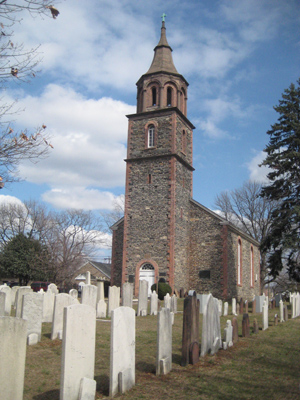 |
The church’s historic 18th-century appearance takes visitors through a journey back to the 1700s. One of the most memorable events to occur during this time was the election of 1733, which took place on the Village Green in front of St. Paul’s Church.
The election raised controversial issues of freedom of religion and the press when John Peter Zenger’s article regarding the election led to a trial where Zenger was prosecuted for seditious libel against New York’s governor, William Cosby. Zenger’s eventual acquittal was viewed as a sign of victory for freedom of speech in America.
During the time of the American Revolution, the church had not been fully built and had no locks to keep outsiders away. Military troops transformed the church into an infirmary after the Revolutionary War Battle at Pell’s Point in 1776.
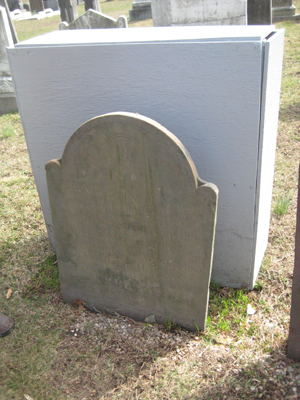 |
This sandstone monument is in memory of Abigail Morgan (1727-82), the wife of Caleb Morgan, a wealthy and prominent leader of the community. The angel on Morgan’s stone represents the soul in heaven, wearing a crown of righteousness (Photo by Valerie Reyes). |
Its large size and central location made it attractive to the military.
“Eventually they took the church. It was a casualty of war,” site manager and tour guide David Osborn said.
Services stopped and ministers went elsewhere. The rebuilding of the church began in 1787, five years after the end of the war.
Today, St. Paul’s Church is a National Historic Site and a place where people can go to get a little taste of life during the colonial era. Four centuries later the church stands in a highly industrialized part of Mt. Vernon, N.Y.
“From the late 1800s to the 1900s things changed and the old idea of a farming community surrounding the church changed,” Osborn said.
With the onset of industrialization and the building of railroads, people moved away from the local church.
| This model shows an unfinished church during the war when military troops had turned it into a hospital (Photo by Valerie Reyes). | 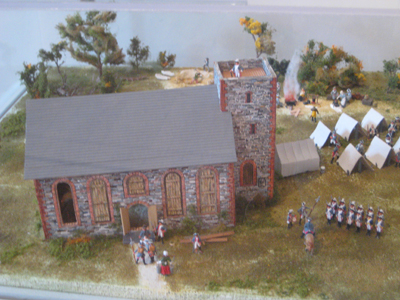 |
“What was at one time a residential community of homes and small farms became industrial and commercial,” Osborn said.
As one of New York’s oldest parishes, it is full of priceless memories and history. The church’s box hubs give visitors a sense of how church-goers stayed warm during those days. During those days people would huddle in their pews with blankets and keep a foot warmer by their feet to trap in heat.
“That’s how you went to church in the winter,” Osborn said.
The church is also home to one of the oldest functioning pipe organs in the country. The 1833 mahogany pipe organ was built by Henry Erben and is still used throughout the year during organ recitals, especially during the holiday season.
“During the time a pipe organ like this cost about $800. Today it is priceless,” Osborn said.
Visitors can also travel up the wooden steps of the 225-year-old tower to see the 1758 bronze bell. Like the Liberty Bell, the two-century-old bell for Eastchester was cast at the Whitehall Chapel Foundry in London.
| Doctors used materials such as these to treat wounded soldiers during the Revolution (Photo by Valerie Reyes). | 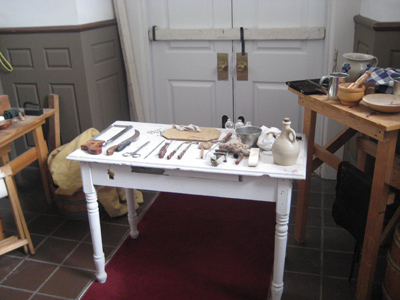 |
Due to cold weather conditions, tours to the top of the tower are only offered during the spring and summer months. The tower is the only part of the church that is not insulated. The stone walls and creaking wooden floor allow visitors to truly envision and experience how the citizens of Eastchester lived during the 18th century.
St. Paul’s Church no longer holds religious services. As a result of the industrialization of the area during the 1900s, church attendance dropped dramatically so that by the 1970s only a handful of people attended.
Osborn said that only two families attended the final church service, which was held on May 28, 1977. The church is still used for special programs put on by the National Park Service and is available for ceremonial events such as weddings.
West of the church stands the site’s museum, which offers many resources for visitors. Upon entrance guests are greeted and asked to sign in. Brochures filled with upcoming programs, events and the church’s history are also made available. Guests can also sit and watch a short introductory video about the history of Eastchester and St. Paul’s Church.
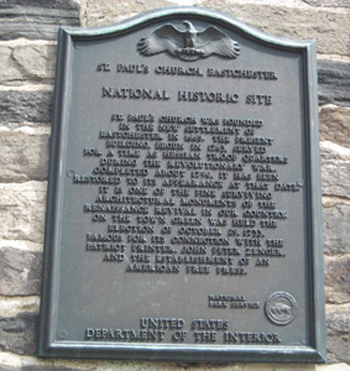 |
Being the site of the monumental Election of 1733, St. Paul’s Church was deeply rooted in the struggle to establish and maintain freedom of speech and of the press (Photo by Valerie Reyes). |
Though the medium- sized building serves as a museum today, during the 1800s it was a carriage house where church visitors would rest their horses and store their carriages during the church service. “It was like an indoor parking lot,” Osborn said.
In 1925, the area was transformed into a parish hall and became a location where children attended Sunday School. It was also common for families to eat supper and celebrate church social gatherings at the parish hall.
It was not until St. Paul’s Church became part of the National Park Service in 1984 that the structure became a museum.
The museum is now a place full of preserved history with photographs and artifacts that tell stories rarely found in history books. The museum’s current exhibition, “St. Paul’s and the Presidents,” reveals the interesting connections that George Washington, John Adams, John Quincy Adams, Abraham Lincoln, and Franklin D. Roosevelt have to St. Paul’s. The presentation also includes a rare audio recording by Dr. Charles F. Taft, the Army surgeon who treated Lincoln after he was shot at Ford’s Theater in Washington, D.C.
| In 1999, the Drake Family window was reinstalled after having been removed during the restoration of the church (Photo by Valerie Reyes). | 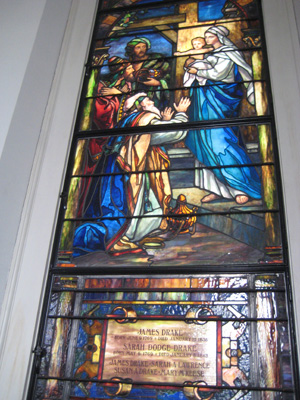 |
Self- guided or staff- led tours of the adjoining cemetery are also available. Visitors can walk the five-acre burial ground, which has more than 9,000 burials. Guests can also explore the 2,500 burial stones that date as far back as 1704. Though faded and weathered due to passing centuries, visitors are still able to read many of the inscriptions on the stones.
Ironically, the writings on the sandstones, which were used during earlier periods, are more legible than those written on marble stones, which became more popular after the American Revolution.
Some notable tombstones are those of Charles Sabin Taft and Richard Shute, the oldest tombstone in the cemetery.
Many of the writings on the earlier stones identified people only by their first and last initial. The reason for this was that during the 18 th century, the town of Eastchester was so small that people could easily be identified by their initials.
It was also common in society during the 18th and 19th centuries for women to be attributed through their husbands. A stone dated Aug. 7, 1782, read: In Memory of Abigail – The wife of Caleb Morgan.
The ancestral cemetery also includes family vaults, where up to nine families are buried under one common structure, separated from everyone else.
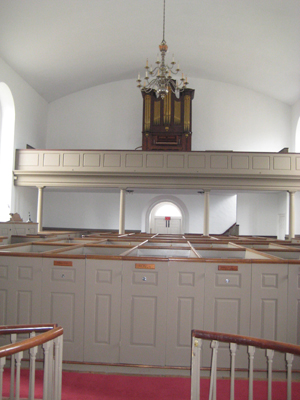 |
A view of the church from the west wing showcases a chandelier as well as the 1833 organ (Photo by Valerie Reyes). |
Though hardly anyone is buried at the cemetery anymore, some people still own family plots and have rights to the grounds.
“There are about 50 to 60 open plots,” Osborn said.
St. Paul’s Church National Historic Site puts on programs year around that keep the rich history of the church and the town of Eastchester alive. The church also offers educational programs for groups as large as 80 students.
These programs feature costumed demonstrations and re-enactments that shed light on the site’s significance in relation to the American Revolution. Schools can take advantage of these programs from October through December and from March through June.
The site offers something for people of all ages with varying levels of knowledge in American history. “Kids come and appreciate it on one level, college kids on another, and seniors on another,” Osborn said. “I recommend this site to anybody that is interested in the great story of America.”
If You Go
- St. Paul’s Church National Historic Site
- 897 South Columbus Ave.
- Mount Vernon, N.Y. 10550
Directions
- Subway: Take #5 train to Dyre Avenue. The church is a 15 minute walk from the train station.
Bus: Bus W-55 operates every half hour from Dyre Avenue station to St. Paul’s Church.
Car: Take exit 13 off I-95 or exit 7 off the Hutchinson River Parkway. - Contact: call 914-667-4116 or visit http://www.nps.gov/sapa
- Hours: Open Monday through Friday from 9 a.m. to 5 p.m. Grounds are open from dawn till dusk
- Admission: Free
- Tours: Church Tower tours will be given every other Friday at 3 p.m. beginning Friday April 24 until June 19.
- Staff- led tours of the site are available any time during operation hours. Advance calling is not necessary, but suggested.
Upcoming Events for Spring and Summer 2009
- Washington’s Spies – Saturday, April 11, from 2 p.m. to 4 p.m.
Acclaimed historian Alexander Rose delves into the world of Revolutionary War espionage, exploring the intrigue of a dedicated group of spies in the New York area who supplied Washington with crucial information during the War of American Independence. Dr. Rose examined this theme in his recently published, Washington’s Spies: The Story of America`s First Spy Ring. His other books include Kings in the North: The House of Percy in British History, and the recently published, The American Rifle: A Biography. A reception follows the talk. - St. Paul’s Historic Dinner – Saturday, May 9, from 5 p.m. to 9 p.m.
A special benefit event recognizing the bicentennial of the birth of Abraham Lincoln. The event features a historic style dinner, Lincoln re-enactor, as well as music and talk commemorating the Civil War president and his connection to St. Paul’s. Call the site at 914-667-4116 for ticket reservations and details. - Colonial Day – Saturday, June 16, from 12 p.m. to 4 p.m.
Colonial era style music, dancing, crafts, games and arms. There`s also a special tour of the colonial section of the historic cemetery, and a concert on the historic pipe organ by concert-organist-in-residence Dr. Jan Piet Knijff.

Comments are Closed